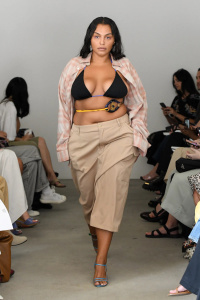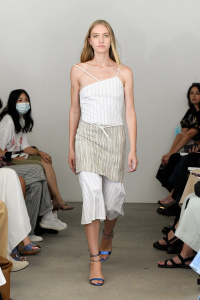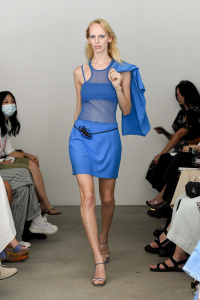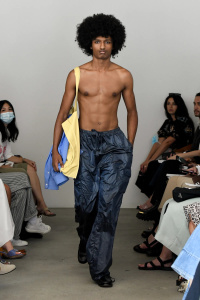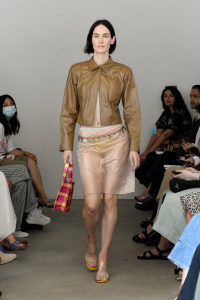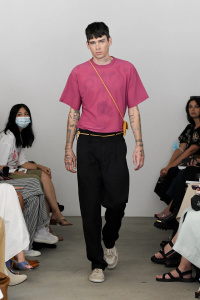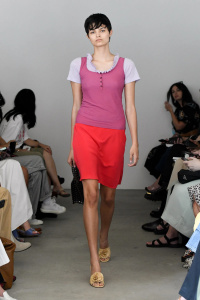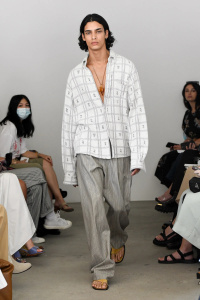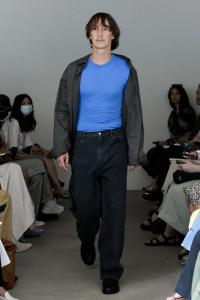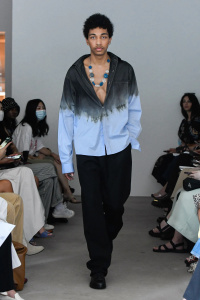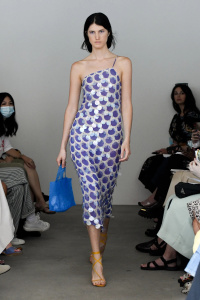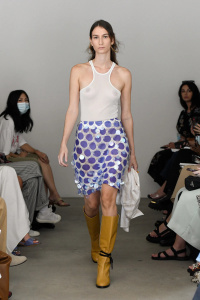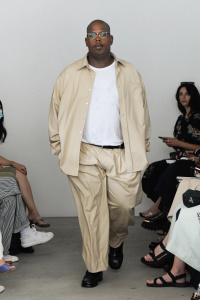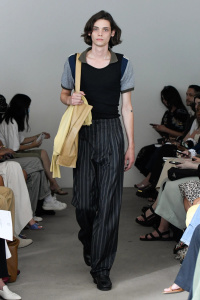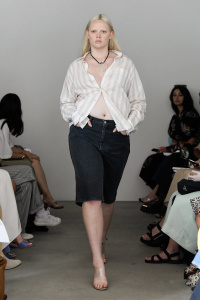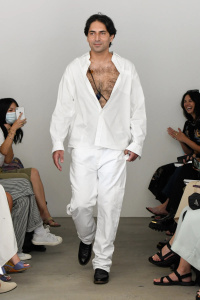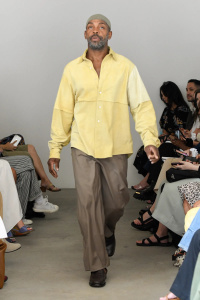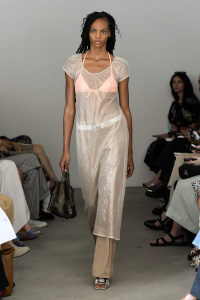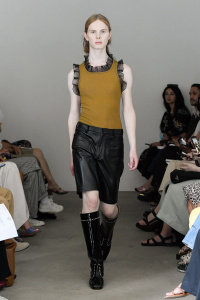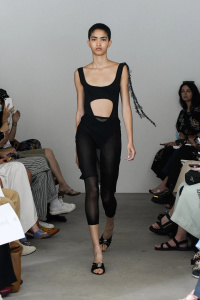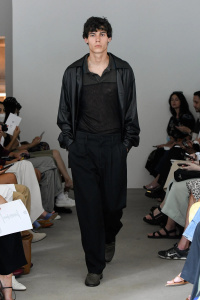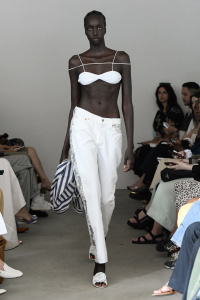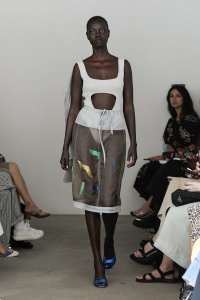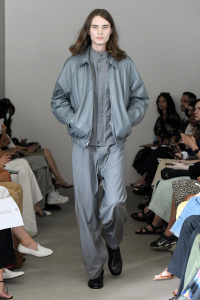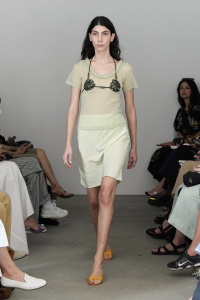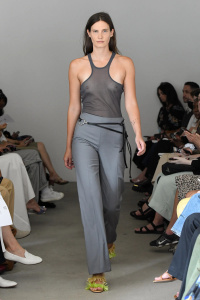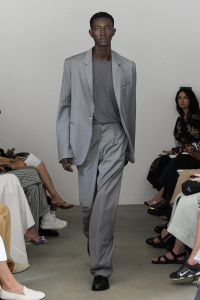You are using an out of date browser. It may not display this or other websites correctly.
You should upgrade or use an alternative browser.
You should upgrade or use an alternative browser.
Maryam Nassir Zadeh S/S 2022 New York
- Thread starter vogue28
- Start date
D
Deleted member 141309
Guest
Why this exists?
Are people behind this still free on the streets and not arrested?
Are people behind this still free on the streets and not arrested?
YohjiAddict
Well-Known Member
- Joined
- May 26, 2016
- Messages
- 3,551
- Reaction score
- 4,818
It's hideous, absolutely hideous. You would seriously come out better dressed in a head-to-toe Zara, 100% rayon ensemble than in any of the looks presented here. The color palette alone could only work at a reformatory.
That studded white belt shouldn't have left the two-cent bin at a mid-western thrift store.
That studded white belt shouldn't have left the two-cent bin at a mid-western thrift store.
rowjellies
Well-Known Member
- Joined
- Jun 25, 2024
- Messages
- 166
- Reaction score
- 429
This was a crazy read

By Madeline Leung Coleman, features writer for New York.

Photo: Marie Tomanova
Recently, a blue puffer jacket made Maryam Nassirzadeh cry. She was trawling her storage when she found it, searching for things of her own that she could add to an upcoming sample sale she was planning at her store. For Nassirzadeh, who designs clothes and accessories and shoes, preparing for the sale was starting to seem like more than a business obligation. She was approaching it as a spiritual purge. Standing in her lower Manhattan studio, Nassirzadeh unearthed the puffer, put it on, and suddenly, she says, “I was bawling.”
The jacket was indigo-dyed and Japanese and a gift from her ex-husband, Uday Kak. They started their store, Maryam Nassir Zadeh, together in 2008 and broke up eight years later. They had never completely disengaged; not long after they split she bought him a puffer just like this, then he bought one for her. Trying it on made her think of when she and Kak were young and their two daughters were small and she was building her business, living her dream. Back then, she didn’t know how good she had it. But wow, she really knew it now. She started to cry because the puffer and the memories it held “felt like a huge hug,” she says. That, and because “the textile is so incredible.”
The era Nassirzadeh was remembering is when she first became a main character in her downtown fashion world — a status she’s maintained ever since, radiating a kind of haphazard, globetrotting glamour that has had an outsize effect on how young women dress. “You’d walk around New York or L.A. and be like, ‘Is that Maryam?’” says the designer Jasmin Shokrian. “No, it would be someone who wanted to look like her — or who wanted to look like they were wearing her clothes.” Her brand, Maryam Nassir Zadeh (with the spelling of her last name tweaked), makes clothes that are simple, often skimpy, and meant to be piled on — fluttery cardigans shrugged over bikini tops, dresses over pants, leather jackets over slips, and wide belts cinched anywhere from upper ribs to hipbone. A typical MNZ outfit looks like it was fished out of a carry-on because you just got back from Ibiza and you’re off to Hydra next week. The brand also makes bags and scrunchies and, since 2020, a few menswear staples, but no matter what it puts out, the best sellers remain the shoes, especially the block-heeled sandals and pumps and teetering wedges that launched a flotilla of imitators. “She would do magical things that you would dream about when you’re a little girl, like a glitter Barbie slide in a weird bronze color,” says Jenn Murray, a creative consultant and friend who also used to work for MNZ. “She wasn’t thinking, We need this height of heel for a person who’s going to be walking all day. There was no consideration of reality. Which was so nice.”
MNZ was born at a time when New York brimmed with interesting little stores and adventurous young designers. While some brands flourished, many more didn’t make it past 2020. MNZ is unusual for staying afloat without ever managing to scale or employing more than a handful of people at a time. Nassirzadeh has no investors. Those who know her well say the brand has no imagined customer: The MNZ woman is simply MNZ herself. For years it seemed as if her personal charisma, social connections, and sharp hiring instincts were enough to keep the brand humming, no matter how hard it felt behind the scenes. As jewelry designer Sophie Buhai, who’s known her for two decades, puts it, “One of Maryam’s greatest strengths is her ability to function in complete chaos.”
Nassirzadeh says that when the brand was growing and her children were young, people always used to ask her: “How do you do it all?” Recently though, fashion observers whisper a different question: “How does she stay in business?” For the first time this year, Nassirzadeh did something many of her peers would’ve done long ago: She collaborated with big corporate clothing brands. The first was a much-discussed collection she designed with J.Crew, the second a capsule she did with ba&sh, a lesser-known French brand trying to make inroads in the U.S. (Two years ago, Nassirzadeh opened a smaller shop in Paris.) While these collaborations were celebrated as proof of MNZ’s influence, they arrived at the nadir of the brand’s fortunes. Over the last few years, Nassirzadeh’s company has contracted by every measure. She used to break ground with the brands she sold at her store, including Jacquemus, Telfar, and Eckhaus Latta; now she mostly just sells her own designs. The MNZ line once did strong wholesale business, selling clothes, accessories, and shoes through Bloomingdale’s and other big stores; now many of those accounts have dropped off, and MNZ only wholesales its shoes. Runway shows have become erratic. Fewer new styles are introduced. Core staff have turned over and the team has shrunk. The J.Crew and ba&sh collaborations traded on Nassirzadeh’s reputation as a trendsetter — which she was, before the pandemic. Now the clothes from those collections are hard to distinguish from the sea of cropped knits and flouncy skirts that flooded the market in her wake.
MNZ’s problems are in some ways typical of small brands. It struggles to compete, to hit price points that the shoppers who admire it can afford. Ready-to-wear is a margins game and inspiration can only take you so far. It’s hard to stay a contender when fast fashion just keeps getting faster, and the SSENSE sale is flooded with newer designers — from Gimaguas to Paloma Wool — making the exact same kind of low-slung belts and bikinis and going-out dresses you were once known for. But this is not how Nassirzadeh tells the story. If you ask her, the crucial issue is that MNZ stopped feeling like her — that there’s a gap between what the brand sells and who she believes herself to be. She was dismayed to realize that she could go into her store and feel like she “wasn’t in love.” She thinks she knows the solution, though: Everything will be better if she can just bring her brand back into alignment with her soul.


.


Clockwise from top left: Öykü Baştaş, Hailey Benton Gates, Jade Magnolia Boulton, and Mari Giudicelli. Photo: Courtesy of Maryam Nassirzadeh.
Nassirzadeh leads me down the hall from the elevator to her apartment, past the long line of Adidas belonging to her two daughters, 12-year-old Lune and 14-year old Anais, and a row of tall, wheeled suitcases packed with old clothes destined for the sample sale. “Those are going to the studio!” she says, stepping into her all-white loft, a sprawling former industrial space in Noho. Walls built out of white-framed windows subdivide the apartment into rooms, all funny little wedges of non-privacy: a tiled galley kitchen, a shared bedroom for the girls, a slice of space that can serve as an office. Ceramic pots and vases from Puglia and the south of France line up along the ledges. It’s Halloween and unseasonably hot; Nassirzadeh wears a closefitting tan tank top from the Italian brand Oscalito over her favorite bikini top from Jacquemus, a shapely tan denim midi skirt from Charlotte Knowles, a pair of MNZ Olympia wedges with clear Perspex straps, and two cameo earrings, one gold hoop earring, a blue glass bangle, gold bangles, a beaded bracelet that spells out “BUBBLES,” multiple pendant necklaces, rings, and her late grandfather’s jade tasbih, or Muslim prayer beads. It’s a lot of jewelry and on her it looks just right. When we move to her bedroom to speak, settling down by tall windows overlooking the city, she brings with her a tube of her signature frosted pink MAC lipstick, which she periodically reapplies without a mirror.
Nassirzadeh has been living in the loft for five years, renting from her “dear friend” Knight Landesman, former publisher of Artforum. (He left the magazine after being accused of sexual harassment by several women in 2017; their case against him was dismissed in late 2018, and Nassirzadeh moved in shortly after.) While she loves living here, she’s not convinced this is the loft’s final form. As we sit by the windows drinking tea, the sun moves across the sky, shooting through a prism hanging on the wall and spraying tiny rainbows directly into Nassirzadeh’s eyes; she doesn’t flinch or even appear to notice, continuing to speak in long, digressive stretches which loop through her personal life, her career, and her spiritual pursuits before landing on the subject of some long-desired goal. “My dream is for this space to be, like, an appointment-only gallery, showroom, studio,” she says, and looks at me with an earnest expression. “Do you think people would come? Do you think they’d come and shop?”
When it comes to running her brand, Nassirzadeh puts great stock in intuition. She means this in roughly the opposite way that Rami Atallah, the founder of SSENSE, did when he told the Times, “I look at data day in and day out. That’s what feeds the intuition. Intuition is not just ‘I feel like doing it.’” Nassirzadeh is all about discovering what she feels like doing. She explains her concept of “divine timing,” which to her means accepting the rate at which all events, including business deals, occur. She repeats the phrase, “When the student is ready, the teacher will appear.” She refers to this as a proverb. When I later look it up, I find it’s a phrase coined by American mystics and often falsely attributed to the Buddha.
Nassirzadeh is not the first designer in her family. In the late 1960s, her maternal grandmother, Essi, opened a women’s boutique in Tehran called Mimi — it was named after Maryam’s late aunt, who is also Nassirzadeh’s namesake. It was the decade before the Iranian Revolution, and Essi stocked the store to reflect her own cosmopolitan chic. She sold hats she designed herself alongside scarves and clothing sourced from Italy and France. Essi’s daughter Zohre, Nassirzadeh’s mother, dressed in Cacharel, Celine, and Louis Vuitton. This is the world Maryam was born into in 1978 and the one her parents fled just three months later, rushing away from the regime change and crash landing in Southern California. Nassirzadeh says her family struggled during the early years: Her parents sunk $100,000 of their savings into a doomed restaurant venture and went bankrupt. But they soon recovered. Both of Nassirzadeh’s parents started working in real estate, her mother as an agent and her father as a mortgage broker, and Maryam grew up in Calabasas.
In 2002, after completing a degree in textile art at RISD, Nassirzadeh moved back to L.A. and started trying to break into fashion. She got a job at a boutique, rented a studio in downtown L.A., and began making and selling her own line of T-shirts, one-of-a-kind garments she would appliqué with bits of found ribbon and brocade and beading. She also started interning for Shokrian, who had recently started her own line as well. “We used to joke all the time that she was more of a stylist than a designer,” says Shokrian. “She would get so mad, but she had a very curatorial eye — she loves to source things.” After a few years, Nassirzadeh moved to New York to study fashion at Parsons. She met Kak, a creative director, standing on the street. As she told one interviewer, “I walked up to him and asked him directions, and we became boyfriend and girlfriend instantly.”
By this point, she wasn’t designing anymore; she’d stopped working on her line when she left L.A. Kak was the one who suggested Nassirzadeh start a store where she could sell other people’s brands. In early 2008, the Lower East Side was full of FOR RENT signs; the couple took out a $300,000 loan from the Small Business Administration and leased a wide open space on Norfolk and Rivington. As they prepared to open, renovating the store, buying plants, and sourcing obscure European and American brands to stock, the housing bubble burst and Wall Street plunged. Maryam Nassir Zadeh opened its doors the same month that Lehman Brothers went bankrupt. “It was so stressful to not know what you’re doing and feel like the economy was sh*t. It was very challenging for us to move forward,” she says. Desperate for cash, she decided to start a showroom, a middleman business which acts as a kind of talent agent and sales representative for brands. They help brands sell to stores and take commission, just like an agent would. Although Nassirzadeh and Kak ran the store together, the showroom was her project; she says he didn’t get why she wanted to do it. She launched it out of the MNZ basement.
This turned out to be one of the best financial decisions Nassirzadeh could make. The showroom, which soon moved to its own space, kept her business afloat and built deep connections to designers who would go on to become influential: MNZ was the first showroom to represent Eckhaus Latta, and among the first to represent brands like Telfar, Apiece Apart, and Lauren Manoogian. She was unusually patient with young, inexperienced designers — perhaps because she’d so recently been one herself. When Nassirzadeh met the shoe designer Martiniano, he had only designed a couple of styles for men; she convinced him to make a version for women, and his so-called glove shoes — super low-profile flats, cut from leather so thin they clung to the foot like a glove — became a polarizing, much-imitated hit. Martiniano says that working with MNZ helped him double his sales over the next few seasons.
In 2011, Nassirzadeh decided it was time to become a designer again. By then, she and Kak had married and had one child. Nassirzadeh took on a recent fashion graduate, Melisa Denizeri Orley, to help with design and production and launched with a small run of shoes. “She was really into an early ’90s-ish Prada sort of thing,” says Denizeri. One of the first designs they made was a block-heeled leather mule sandal, which Denizeri calls a “no-brainer: comfortable, flattering, and everybody wants a bit of height.” The mules came with wide, arch-hugging straps in colors like tangerine and patent cinnamon brown. MNZ added strappy heels, loafers, boots, and ballerinas, as well as women’s clothing, producing small collections of high-waisted pants, skirts, trench coats, and crop tops in New York’s Garment District. But it was the shoes that hit. By 2015, a new drop could cause minor panic. “We would have women calling from around the country saying, ‘I want the clear slipper that went online yesterday and it’s already sold out!’” remembers someone who worked in the store at the time. “I had one woman who would call and literally offer to send me cash directly. She was like, ‘What is your address? I will send you $200 if you can hold a size 40 for me.’” Suddenly MNZ was selling thousands of pairs a year — which former employee Pia Bergman knows because, at first, “We were shipping every single box ourselves.” (Eventually, they had to contract shipping to another company.)
MNZ’s 2017 show at an outdoor running track. Photo: Courtesy of Maryam Nassirzadeh
From the outside, MNZ looked glamorous and growing. By late 2015, its designs were starting to be knocked off — Bergman jumped in to help write a press release when it looked like another small brand, Mansur Gavriel, had copied MNZ’s famous mules. (Mansur Gavriel always denied it.) The brand started staging seasonal shows where Nassirzadeh’s downtown-famous friends like designers Ana Kraš and Mari Giudicelli and artist Susan Cianciolo would walk the runway, often in unexpected settings — like the outdoor running track that hosted a 2017 show, during which random New Yorkers continued to work out as models strutted and Solange performed. It was an aspirational yet approachable universe, bolstered by Nassirzadeh’s habit of using the brand’s official Instagram as her personal photo dump for mirror selfies and vacations pics. Nassirzadeh traveled for weeks or months out of the year, sometimes to visit factories in Europe, and often on inspiration trips that could be hard to distinguish from vacations. “That’s probably where a lot of the money goes because she’s always somewhere. She knows she needs that to be inspired,” says Murray. “She goes to Paris, Ibiza, Turkey all the time. Literally, if you told her, ‘There are these really cool kids living on the moon,’ she’d be like, ‘I need to get there.’” Those who worked for her say that Nassirzadeh had a talent for hiring ambitious young people who she was willing to give an unusual amount of responsibility: Someone who started out in the store might find themselves styling a runway show or shooting a lookbook or even — as is the case for Nassirzadeh’s longtime collaborator Jennifer Park — designing the clothes.
But no matter how successful the brand looked, people who worked there say it never stopped feeling precarious. During MNZ’s boom years, from 2015 to 2019, former employees say there were never more than five or six people working behind the scenes and several more employed in the store. As sales increased, so did spending, to the point where the company’s finances could never quite stabilize. Nassirzadeh would often refer to MNZ as a “family” — albeit one in which, as one person put it, she was not the mother but rather one of the sisters — and normal parts of work could feel unnecessarily charged. (More than one person asked me: “Has she mentioned she’s a Gemini?” — a go-to explanation for her big feelings.) Leaving a job at MNZ was often a turbulent, drawn-out, even tearful negotiation which former employees say Nassirzadeh would inflect with the tenor of a breakup. Some said that she pressured them to hire and train their replacements before they could leave, a process which could take months.
Nassirzadeh denied that she had ever required an employee to do this. “I don’t think that is something that can be forced but I will say, it is only natural that this is considerate and showing value, appreciation, and integrity to give notice and help train the next team member,” she said. She added that most of the employees who had done this chose to because they “felt so loyal to the company.”
During this period of growth, in 2016, Nassirzadeh went through an actual breakup: she and Kak split and he left the business. “There was a lot of struggle and turmoil in the relationship,” Nassirzadeh says. “It was an organic thing, how we broke up, and was honestly the best thing that happened to me.” Their daughters stayed with her and she quickly moved on, falling for a skater and his fashion sense; entranced by his mix of Levi’s, flannels, and Dries, she started dreaming about a men’s line. She dated a lot. “She’s really comfortable with gray area,” says Murray. “She’ll kiss a guy and be like, ‘I think he’s gay, but who cares? It’s wonderful. I don’t need anything from him.’” Then, shortly after Nassirzadeh and the kids moved into their white loft in 2019, she and Kak got back together — and he moved in too. “There had been so much strife, but the beauty is, when we came back together for the second time, it was such a different relationship. There was no judgment,” she says. (The two are now broken up again but remain on good terms.)
Meanwhile, the collections kept coming and the shoes, especially, kept selling. In 2019, people who worked there at the time say that the brand sold about 13,000 pairs of shoes, making up about 80 percent of the brand’s business. (Nassirzadeh would not confirm sales numbers.) MNZ started 2020 in a relatively stable place. As the pandemic hit and other brands scaled back in an attempt to stay afloat, MNZ added menswear to its new collection, including well-cut trousers and shirts and jackets. Nassirzadeh flew to Turkey in August 2020, where she vacationed with Kak and their kids in the resort town of Bodrum before returning to New York. She was so inspired by the trip that she decided to shoot her next lookbook in Bodrum too — and flew back weeks later, this time with the stylist and photographer Thistle Brown in tow. They cast the spring 2021 lookbook with a bunch of skaters from Istanbul. “That’s one of my favorite collections. And those guys, wow — they’re the most dear, special friends for life,” Nassirzadeh tells me. I ask her what it was like to fly all the way to Turkey during the first pandemic summer. She looks perplexed. “They didn’t have any restrictions. It was cool to travel there,” she says. And besides: “I had a vision.”
Nassirzadeh in her apartment. Photo: Marie Tomanova
New York used to be a real shopping town. When MNZ opened, it joined independent boutiques all over downtown and gentrified Brooklyn where you could go find clothes you had never seen before. There was Opening Ceremony, Odin, No. 6, and Assembly New York. Aloha Rag, Creatures of Comfort, and American Two Shot. Steven Alan, like MNZ, ran a multi-brand showroom of its own. In gentrified Brooklyn, there was Bird and In God We Trust. Many of these stores designed their own house line, and the big money people saw their value: in 2009, the year after MNZ opened, Uniqlo collaborated with both Steven Alan and Opening Ceremony. But below all this brick and mortar ran an algorithmic stream, and around 2017, it began to erode the foundations. In 2000, Net-a-Porter was founded. Then SSENSE. Then Farfetch. Department stores stepped up their e-commerce. And all of these websites did crazy, unbeatable sales. Smaller stores just could not compete. In 2017, Odin started downsizing, closing two of its stores. In 2018, Creatures of Comfort closed. The next year, Steven Alan stopped wholesaling its house line and shuttered its flagship. In January 2020, Opening Ceremony sold its IP to a management group and announced it would be closing its stores. Later that year, the alliance of Need Supply and Totokaelo — independent stores that had tried to succeed online — closed too. In 2021, exit Bird.
MNZ was more protected, at least for a while. Its tripartite structure, with the store, brand, and showroom, gave it more ways to lean as the wind blew to and fro. But the showroom stopped raking it in: The more successful brands it represented, including knitwear designer Lauren Manoogian (“a big driver for me,” says Nassirzadeh, “a lucrative commercial brand”) stopped working with MNZ and took their sales in-house. In 2021, Nassirzadeh admitted to Vogue that MNZ had been struggling to cover the cost of new samples for its clothes. In December, the brand’s talented production manager Claire McKinney quit to focus on her own line, SC103. By 2022, finances were dire. “Business was very, very hard—almost like, How am I going to make this?” Nassirzadeh says. “It looked like maybe I just couldn’t continue to produce in a material way.” Money was the problem but in interviews she gave at the time, she aimed her frustration at the idea that the brand had lost touch with her aesthetic. “For so long, with my New York store, my energy has been disconnected in a way. It’s multi-brand and it’s formulaic,” she told one interviewer. “I’m behind the team that styles it and I’m behind the merchandise because I helped buy it, but there’s some things that don’t have my essence, my touch — the vibe.”
The seams were visible if you were looking for them. What Nassirzadeh called her resort 2021 collection included no new designs, just a selection of preexisting garments that her team restyled and photographed for a lookbook. The approach for resort 2022 seemed much the same, and for spring 2023, Nassirzadeh and her team gave familiar styles the appearance of difference by tying bits of fabric — tablecloths, towels — around the models’ waists and chests. For fall 2023, she skipped Fashion Week and shot the lookbook at her parents’ house in Calabasas, again repeating many cuts from past seasons that she layered and styled with vintage pieces. The MNZ store stopped stocking other brands. It also stopped wholesaling its own clothes to other retailers, although it continued to wholesale shoes; they were still the brand’s cornerstone even if, according to former employees, MNZ was now only selling about 3,000 pairs a year, a steep decline from pre-pandemic numbers. Nassirzadeh made the rounds of her Italian shoe factories, wondering if she should try to produce clothes there too. “I was having qualms about where I produce here in the Garment District, like maybe that was an ingredient that was making things not quite right,” she says. “Maybe I just needed new hands and new energy.”
Then a friend swooped in: Beau Wollens, of the brand Noah, orchestrated a meeting between her and Olympia Gayot, J.Crew’s head of women’s and kids’ design. (Wollens’s Noah colleague Brendon Babenzien is now head of menswear at J.Crew.) J.Crew regularly collaborates with smaller brands, trading on their street cred in exchange for offering production resources — and a lower price point — that an independent designer can rarely afford. At first, Nassirzadeh wasn’t sure it made sense. “I loved J.Crew when I was younger. But then for so many years, it wasn’t on my radar,” she says. Meeting Gayot in June 2023 convinced her: “There was such a connection. It was just this effortless and vibrant happening.” But also: MNZ really needed this. They signed the deal. This year, her J.Crew collaboration came out in July, followed by her smaller collaboration with French brand ba&sh two months later.
Working with J.Crew’s resources gave her a new perspective. “It’s so commercial in this way that I didn’t realize how much I loved it. Like this,” Nassirzadeh says the first time we meet, gesturing to my stretchy long-sleeve T-shirt which she immediately clocked for a Michael Stars. “The perfect success of the commercial. The weight and the longevity and the viability. With ours … I’m not downplaying it, because people love what we do. But I definitely feel sometimes that we’re in-between. We don’t have a team with the manpower to execute things in the most technical ways. There’s some good things, like the shoes. Our clothes are more ethereal.” She corrects herself: “They’re solid. The clothes are solid.”
For many customers, the J.Crew collaboration made MNZ products affordable for the first time. Although those who work in the industry argue that MNZ’s shoes, made in Italy and Turkey, are well-priced for their quality — a pair of heeled sandals runs $450 — no one disputes that the clothes cost a lot for what they are. This is in part because they’re mostly produced in New York; a small brand like MNZ can’t meet the minimum order required to make clothes in big foreign factories. The prices bring in a contradiction. As one of my colleagues said, the brand’s look most appeals to a “downtown demographic who can’t afford a $200 dollar T-shirt.” (Make that $430, the price for a white jersey henley from the current collection.) During a recent visit to the store, I tried on a pair of MNZ’s stretchy, bootlegged “dance pants,” which Nassirzadeh told me is one of their more popular products; even as someone who thinks nothing of walking to the yoga studio in leggings, I found the pants’ fabric so thin and revealing that it was hard to imagine wearing them outside. Before going on sale, they cost $315. A flowy cotton skirt is $885. A polyester tank top, $315. A skirt trimmed with long, swaying fringe, $1,760. Meanwhile, an MNZ x J.Crew T-shirt was $49 and a cropped cardigan was $98. A midi dress went for $248, and that was before the markdown. It’s impossible not to compare the quality you get for each price point — and for some of the MNZ products, the quality seems more or less the same as the ones made with J.Crew.
The ba&sh collection was brokered by the consultant Chrissie Miller, who acts as a matchmaker for brands looking to do collaborations. When I ask Miller if designers are ever nervous about lowering their price point, she says, “I mean, if I were giving that designer advice, I would say, here’s an opportunity for you to make something that’s more accessible.” The designers of Eckhaus Latta have done their own collabs with big brands like Camper and Ugg, and they say it’s a great way to both get exposure and make, as Zoe Latta puts it, an “off-cadence check. When you’re running a small business, it’s a hand-to-mouth endeavor.” Even so, a brand can’t dine out on a collab forever. Generally speaking, “these are not big money deals,” says Miller. “It’s not like there’s so much more money,” says Nassirzadeh.
A week and a half after visiting Nassirzadeh’s loft, I go to the MNZ sample sale. I show up on the last day expecting a post-apocalyptic scene, a store stripped down to its studs. Instead the room is calm, the stock robust. A few shoppers drift around the space, digging through boxes piled with old styles of MNZ shoes. The racks are still packed with inventory, from MNZ, brands culled from the store’s offerings, and from Nassirzadeh’s own closet, with her castoffs framed as “archive.” I’m surprised by how much is still left, although the still-high prices might be responsible: A paper posted on the wall doesn’t list a single style of shoe below $100, with boots listed for $200 — and some of them are pretty beat up. I spot a few MNZ x J.Crew skirts and cardigans on the racks. A stack of blankets, rugs, and other textiles spills off a side table. I turn over a Madras pillow case priced at $75 to find a dry-cleaner claim check still pinned to it, made out to UDAY KAK.
After the sale, Nassirzadeh planned to redo the store and the studio. The financial strain of the past few years seems forgotten, or at least repressed. She’s back to dreaming — because, as she tells me, “It doesn’t matter if other people love it and it sells if I’m not living up to my potential.” She has other people and brands she wants to work with, mainly an Italian heritage brand she’s been speaking to about doing private-label homewares. High end, European, and resort-y, “they’re more where I want MNZ to be.” Last month, she released the MNZ lookbook for spring 2025 — unisex offerings of plain pants and shirts are awash in frippery, float, and frill: ice-creamy ruffles over trousers, see-through dresses that land just this side of beach cover-ups. It’s as ethereal as ever, which is how Nassirzadeh likes it — she’s always preferred spring collections over fall. I ask her why. “Are you kidding me?” she says. “I’m such a summer baby. I’m like ultimate summer forever.”
How Does Maryam Nassir Zadeh Stay in Business?
The brand once defined how downtown girls wanted to dress. Now it’s a mystery how it survives at all.

By Madeline Leung Coleman, features writer for New York.

Photo: Marie Tomanova
Recently, a blue puffer jacket made Maryam Nassirzadeh cry. She was trawling her storage when she found it, searching for things of her own that she could add to an upcoming sample sale she was planning at her store. For Nassirzadeh, who designs clothes and accessories and shoes, preparing for the sale was starting to seem like more than a business obligation. She was approaching it as a spiritual purge. Standing in her lower Manhattan studio, Nassirzadeh unearthed the puffer, put it on, and suddenly, she says, “I was bawling.”
The jacket was indigo-dyed and Japanese and a gift from her ex-husband, Uday Kak. They started their store, Maryam Nassir Zadeh, together in 2008 and broke up eight years later. They had never completely disengaged; not long after they split she bought him a puffer just like this, then he bought one for her. Trying it on made her think of when she and Kak were young and their two daughters were small and she was building her business, living her dream. Back then, she didn’t know how good she had it. But wow, she really knew it now. She started to cry because the puffer and the memories it held “felt like a huge hug,” she says. That, and because “the textile is so incredible.”
The era Nassirzadeh was remembering is when she first became a main character in her downtown fashion world — a status she’s maintained ever since, radiating a kind of haphazard, globetrotting glamour that has had an outsize effect on how young women dress. “You’d walk around New York or L.A. and be like, ‘Is that Maryam?’” says the designer Jasmin Shokrian. “No, it would be someone who wanted to look like her — or who wanted to look like they were wearing her clothes.” Her brand, Maryam Nassir Zadeh (with the spelling of her last name tweaked), makes clothes that are simple, often skimpy, and meant to be piled on — fluttery cardigans shrugged over bikini tops, dresses over pants, leather jackets over slips, and wide belts cinched anywhere from upper ribs to hipbone. A typical MNZ outfit looks like it was fished out of a carry-on because you just got back from Ibiza and you’re off to Hydra next week. The brand also makes bags and scrunchies and, since 2020, a few menswear staples, but no matter what it puts out, the best sellers remain the shoes, especially the block-heeled sandals and pumps and teetering wedges that launched a flotilla of imitators. “She would do magical things that you would dream about when you’re a little girl, like a glitter Barbie slide in a weird bronze color,” says Jenn Murray, a creative consultant and friend who also used to work for MNZ. “She wasn’t thinking, We need this height of heel for a person who’s going to be walking all day. There was no consideration of reality. Which was so nice.”
MNZ was born at a time when New York brimmed with interesting little stores and adventurous young designers. While some brands flourished, many more didn’t make it past 2020. MNZ is unusual for staying afloat without ever managing to scale or employing more than a handful of people at a time. Nassirzadeh has no investors. Those who know her well say the brand has no imagined customer: The MNZ woman is simply MNZ herself. For years it seemed as if her personal charisma, social connections, and sharp hiring instincts were enough to keep the brand humming, no matter how hard it felt behind the scenes. As jewelry designer Sophie Buhai, who’s known her for two decades, puts it, “One of Maryam’s greatest strengths is her ability to function in complete chaos.”
Nassirzadeh says that when the brand was growing and her children were young, people always used to ask her: “How do you do it all?” Recently though, fashion observers whisper a different question: “How does she stay in business?” For the first time this year, Nassirzadeh did something many of her peers would’ve done long ago: She collaborated with big corporate clothing brands. The first was a much-discussed collection she designed with J.Crew, the second a capsule she did with ba&sh, a lesser-known French brand trying to make inroads in the U.S. (Two years ago, Nassirzadeh opened a smaller shop in Paris.) While these collaborations were celebrated as proof of MNZ’s influence, they arrived at the nadir of the brand’s fortunes. Over the last few years, Nassirzadeh’s company has contracted by every measure. She used to break ground with the brands she sold at her store, including Jacquemus, Telfar, and Eckhaus Latta; now she mostly just sells her own designs. The MNZ line once did strong wholesale business, selling clothes, accessories, and shoes through Bloomingdale’s and other big stores; now many of those accounts have dropped off, and MNZ only wholesales its shoes. Runway shows have become erratic. Fewer new styles are introduced. Core staff have turned over and the team has shrunk. The J.Crew and ba&sh collaborations traded on Nassirzadeh’s reputation as a trendsetter — which she was, before the pandemic. Now the clothes from those collections are hard to distinguish from the sea of cropped knits and flouncy skirts that flooded the market in her wake.
MNZ’s problems are in some ways typical of small brands. It struggles to compete, to hit price points that the shoppers who admire it can afford. Ready-to-wear is a margins game and inspiration can only take you so far. It’s hard to stay a contender when fast fashion just keeps getting faster, and the SSENSE sale is flooded with newer designers — from Gimaguas to Paloma Wool — making the exact same kind of low-slung belts and bikinis and going-out dresses you were once known for. But this is not how Nassirzadeh tells the story. If you ask her, the crucial issue is that MNZ stopped feeling like her — that there’s a gap between what the brand sells and who she believes herself to be. She was dismayed to realize that she could go into her store and feel like she “wasn’t in love.” She thinks she knows the solution, though: Everything will be better if she can just bring her brand back into alignment with her soul.
The MNZ Woman


.


Clockwise from top left: Öykü Baştaş, Hailey Benton Gates, Jade Magnolia Boulton, and Mari Giudicelli. Photo: Courtesy of Maryam Nassirzadeh.
Nassirzadeh leads me down the hall from the elevator to her apartment, past the long line of Adidas belonging to her two daughters, 12-year-old Lune and 14-year old Anais, and a row of tall, wheeled suitcases packed with old clothes destined for the sample sale. “Those are going to the studio!” she says, stepping into her all-white loft, a sprawling former industrial space in Noho. Walls built out of white-framed windows subdivide the apartment into rooms, all funny little wedges of non-privacy: a tiled galley kitchen, a shared bedroom for the girls, a slice of space that can serve as an office. Ceramic pots and vases from Puglia and the south of France line up along the ledges. It’s Halloween and unseasonably hot; Nassirzadeh wears a closefitting tan tank top from the Italian brand Oscalito over her favorite bikini top from Jacquemus, a shapely tan denim midi skirt from Charlotte Knowles, a pair of MNZ Olympia wedges with clear Perspex straps, and two cameo earrings, one gold hoop earring, a blue glass bangle, gold bangles, a beaded bracelet that spells out “BUBBLES,” multiple pendant necklaces, rings, and her late grandfather’s jade tasbih, or Muslim prayer beads. It’s a lot of jewelry and on her it looks just right. When we move to her bedroom to speak, settling down by tall windows overlooking the city, she brings with her a tube of her signature frosted pink MAC lipstick, which she periodically reapplies without a mirror.
Nassirzadeh has been living in the loft for five years, renting from her “dear friend” Knight Landesman, former publisher of Artforum. (He left the magazine after being accused of sexual harassment by several women in 2017; their case against him was dismissed in late 2018, and Nassirzadeh moved in shortly after.) While she loves living here, she’s not convinced this is the loft’s final form. As we sit by the windows drinking tea, the sun moves across the sky, shooting through a prism hanging on the wall and spraying tiny rainbows directly into Nassirzadeh’s eyes; she doesn’t flinch or even appear to notice, continuing to speak in long, digressive stretches which loop through her personal life, her career, and her spiritual pursuits before landing on the subject of some long-desired goal. “My dream is for this space to be, like, an appointment-only gallery, showroom, studio,” she says, and looks at me with an earnest expression. “Do you think people would come? Do you think they’d come and shop?”
When it comes to running her brand, Nassirzadeh puts great stock in intuition. She means this in roughly the opposite way that Rami Atallah, the founder of SSENSE, did when he told the Times, “I look at data day in and day out. That’s what feeds the intuition. Intuition is not just ‘I feel like doing it.’” Nassirzadeh is all about discovering what she feels like doing. She explains her concept of “divine timing,” which to her means accepting the rate at which all events, including business deals, occur. She repeats the phrase, “When the student is ready, the teacher will appear.” She refers to this as a proverb. When I later look it up, I find it’s a phrase coined by American mystics and often falsely attributed to the Buddha.
Nassirzadeh is not the first designer in her family. In the late 1960s, her maternal grandmother, Essi, opened a women’s boutique in Tehran called Mimi — it was named after Maryam’s late aunt, who is also Nassirzadeh’s namesake. It was the decade before the Iranian Revolution, and Essi stocked the store to reflect her own cosmopolitan chic. She sold hats she designed herself alongside scarves and clothing sourced from Italy and France. Essi’s daughter Zohre, Nassirzadeh’s mother, dressed in Cacharel, Celine, and Louis Vuitton. This is the world Maryam was born into in 1978 and the one her parents fled just three months later, rushing away from the regime change and crash landing in Southern California. Nassirzadeh says her family struggled during the early years: Her parents sunk $100,000 of their savings into a doomed restaurant venture and went bankrupt. But they soon recovered. Both of Nassirzadeh’s parents started working in real estate, her mother as an agent and her father as a mortgage broker, and Maryam grew up in Calabasas.
In 2002, after completing a degree in textile art at RISD, Nassirzadeh moved back to L.A. and started trying to break into fashion. She got a job at a boutique, rented a studio in downtown L.A., and began making and selling her own line of T-shirts, one-of-a-kind garments she would appliqué with bits of found ribbon and brocade and beading. She also started interning for Shokrian, who had recently started her own line as well. “We used to joke all the time that she was more of a stylist than a designer,” says Shokrian. “She would get so mad, but she had a very curatorial eye — she loves to source things.” After a few years, Nassirzadeh moved to New York to study fashion at Parsons. She met Kak, a creative director, standing on the street. As she told one interviewer, “I walked up to him and asked him directions, and we became boyfriend and girlfriend instantly.”
By this point, she wasn’t designing anymore; she’d stopped working on her line when she left L.A. Kak was the one who suggested Nassirzadeh start a store where she could sell other people’s brands. In early 2008, the Lower East Side was full of FOR RENT signs; the couple took out a $300,000 loan from the Small Business Administration and leased a wide open space on Norfolk and Rivington. As they prepared to open, renovating the store, buying plants, and sourcing obscure European and American brands to stock, the housing bubble burst and Wall Street plunged. Maryam Nassir Zadeh opened its doors the same month that Lehman Brothers went bankrupt. “It was so stressful to not know what you’re doing and feel like the economy was sh*t. It was very challenging for us to move forward,” she says. Desperate for cash, she decided to start a showroom, a middleman business which acts as a kind of talent agent and sales representative for brands. They help brands sell to stores and take commission, just like an agent would. Although Nassirzadeh and Kak ran the store together, the showroom was her project; she says he didn’t get why she wanted to do it. She launched it out of the MNZ basement.
This turned out to be one of the best financial decisions Nassirzadeh could make. The showroom, which soon moved to its own space, kept her business afloat and built deep connections to designers who would go on to become influential: MNZ was the first showroom to represent Eckhaus Latta, and among the first to represent brands like Telfar, Apiece Apart, and Lauren Manoogian. She was unusually patient with young, inexperienced designers — perhaps because she’d so recently been one herself. When Nassirzadeh met the shoe designer Martiniano, he had only designed a couple of styles for men; she convinced him to make a version for women, and his so-called glove shoes — super low-profile flats, cut from leather so thin they clung to the foot like a glove — became a polarizing, much-imitated hit. Martiniano says that working with MNZ helped him double his sales over the next few seasons.
In 2011, Nassirzadeh decided it was time to become a designer again. By then, she and Kak had married and had one child. Nassirzadeh took on a recent fashion graduate, Melisa Denizeri Orley, to help with design and production and launched with a small run of shoes. “She was really into an early ’90s-ish Prada sort of thing,” says Denizeri. One of the first designs they made was a block-heeled leather mule sandal, which Denizeri calls a “no-brainer: comfortable, flattering, and everybody wants a bit of height.” The mules came with wide, arch-hugging straps in colors like tangerine and patent cinnamon brown. MNZ added strappy heels, loafers, boots, and ballerinas, as well as women’s clothing, producing small collections of high-waisted pants, skirts, trench coats, and crop tops in New York’s Garment District. But it was the shoes that hit. By 2015, a new drop could cause minor panic. “We would have women calling from around the country saying, ‘I want the clear slipper that went online yesterday and it’s already sold out!’” remembers someone who worked in the store at the time. “I had one woman who would call and literally offer to send me cash directly. She was like, ‘What is your address? I will send you $200 if you can hold a size 40 for me.’” Suddenly MNZ was selling thousands of pairs a year — which former employee Pia Bergman knows because, at first, “We were shipping every single box ourselves.” (Eventually, they had to contract shipping to another company.)
MNZ’s 2017 show at an outdoor running track. Photo: Courtesy of Maryam Nassirzadeh
From the outside, MNZ looked glamorous and growing. By late 2015, its designs were starting to be knocked off — Bergman jumped in to help write a press release when it looked like another small brand, Mansur Gavriel, had copied MNZ’s famous mules. (Mansur Gavriel always denied it.) The brand started staging seasonal shows where Nassirzadeh’s downtown-famous friends like designers Ana Kraš and Mari Giudicelli and artist Susan Cianciolo would walk the runway, often in unexpected settings — like the outdoor running track that hosted a 2017 show, during which random New Yorkers continued to work out as models strutted and Solange performed. It was an aspirational yet approachable universe, bolstered by Nassirzadeh’s habit of using the brand’s official Instagram as her personal photo dump for mirror selfies and vacations pics. Nassirzadeh traveled for weeks or months out of the year, sometimes to visit factories in Europe, and often on inspiration trips that could be hard to distinguish from vacations. “That’s probably where a lot of the money goes because she’s always somewhere. She knows she needs that to be inspired,” says Murray. “She goes to Paris, Ibiza, Turkey all the time. Literally, if you told her, ‘There are these really cool kids living on the moon,’ she’d be like, ‘I need to get there.’” Those who worked for her say that Nassirzadeh had a talent for hiring ambitious young people who she was willing to give an unusual amount of responsibility: Someone who started out in the store might find themselves styling a runway show or shooting a lookbook or even — as is the case for Nassirzadeh’s longtime collaborator Jennifer Park — designing the clothes.
But no matter how successful the brand looked, people who worked there say it never stopped feeling precarious. During MNZ’s boom years, from 2015 to 2019, former employees say there were never more than five or six people working behind the scenes and several more employed in the store. As sales increased, so did spending, to the point where the company’s finances could never quite stabilize. Nassirzadeh would often refer to MNZ as a “family” — albeit one in which, as one person put it, she was not the mother but rather one of the sisters — and normal parts of work could feel unnecessarily charged. (More than one person asked me: “Has she mentioned she’s a Gemini?” — a go-to explanation for her big feelings.) Leaving a job at MNZ was often a turbulent, drawn-out, even tearful negotiation which former employees say Nassirzadeh would inflect with the tenor of a breakup. Some said that she pressured them to hire and train their replacements before they could leave, a process which could take months.
Nassirzadeh denied that she had ever required an employee to do this. “I don’t think that is something that can be forced but I will say, it is only natural that this is considerate and showing value, appreciation, and integrity to give notice and help train the next team member,” she said. She added that most of the employees who had done this chose to because they “felt so loyal to the company.”
During this period of growth, in 2016, Nassirzadeh went through an actual breakup: she and Kak split and he left the business. “There was a lot of struggle and turmoil in the relationship,” Nassirzadeh says. “It was an organic thing, how we broke up, and was honestly the best thing that happened to me.” Their daughters stayed with her and she quickly moved on, falling for a skater and his fashion sense; entranced by his mix of Levi’s, flannels, and Dries, she started dreaming about a men’s line. She dated a lot. “She’s really comfortable with gray area,” says Murray. “She’ll kiss a guy and be like, ‘I think he’s gay, but who cares? It’s wonderful. I don’t need anything from him.’” Then, shortly after Nassirzadeh and the kids moved into their white loft in 2019, she and Kak got back together — and he moved in too. “There had been so much strife, but the beauty is, when we came back together for the second time, it was such a different relationship. There was no judgment,” she says. (The two are now broken up again but remain on good terms.)
Meanwhile, the collections kept coming and the shoes, especially, kept selling. In 2019, people who worked there at the time say that the brand sold about 13,000 pairs of shoes, making up about 80 percent of the brand’s business. (Nassirzadeh would not confirm sales numbers.) MNZ started 2020 in a relatively stable place. As the pandemic hit and other brands scaled back in an attempt to stay afloat, MNZ added menswear to its new collection, including well-cut trousers and shirts and jackets. Nassirzadeh flew to Turkey in August 2020, where she vacationed with Kak and their kids in the resort town of Bodrum before returning to New York. She was so inspired by the trip that she decided to shoot her next lookbook in Bodrum too — and flew back weeks later, this time with the stylist and photographer Thistle Brown in tow. They cast the spring 2021 lookbook with a bunch of skaters from Istanbul. “That’s one of my favorite collections. And those guys, wow — they’re the most dear, special friends for life,” Nassirzadeh tells me. I ask her what it was like to fly all the way to Turkey during the first pandemic summer. She looks perplexed. “They didn’t have any restrictions. It was cool to travel there,” she says. And besides: “I had a vision.”
Nassirzadeh in her apartment. Photo: Marie Tomanova
New York used to be a real shopping town. When MNZ opened, it joined independent boutiques all over downtown and gentrified Brooklyn where you could go find clothes you had never seen before. There was Opening Ceremony, Odin, No. 6, and Assembly New York. Aloha Rag, Creatures of Comfort, and American Two Shot. Steven Alan, like MNZ, ran a multi-brand showroom of its own. In gentrified Brooklyn, there was Bird and In God We Trust. Many of these stores designed their own house line, and the big money people saw their value: in 2009, the year after MNZ opened, Uniqlo collaborated with both Steven Alan and Opening Ceremony. But below all this brick and mortar ran an algorithmic stream, and around 2017, it began to erode the foundations. In 2000, Net-a-Porter was founded. Then SSENSE. Then Farfetch. Department stores stepped up their e-commerce. And all of these websites did crazy, unbeatable sales. Smaller stores just could not compete. In 2017, Odin started downsizing, closing two of its stores. In 2018, Creatures of Comfort closed. The next year, Steven Alan stopped wholesaling its house line and shuttered its flagship. In January 2020, Opening Ceremony sold its IP to a management group and announced it would be closing its stores. Later that year, the alliance of Need Supply and Totokaelo — independent stores that had tried to succeed online — closed too. In 2021, exit Bird.
MNZ was more protected, at least for a while. Its tripartite structure, with the store, brand, and showroom, gave it more ways to lean as the wind blew to and fro. But the showroom stopped raking it in: The more successful brands it represented, including knitwear designer Lauren Manoogian (“a big driver for me,” says Nassirzadeh, “a lucrative commercial brand”) stopped working with MNZ and took their sales in-house. In 2021, Nassirzadeh admitted to Vogue that MNZ had been struggling to cover the cost of new samples for its clothes. In December, the brand’s talented production manager Claire McKinney quit to focus on her own line, SC103. By 2022, finances were dire. “Business was very, very hard—almost like, How am I going to make this?” Nassirzadeh says. “It looked like maybe I just couldn’t continue to produce in a material way.” Money was the problem but in interviews she gave at the time, she aimed her frustration at the idea that the brand had lost touch with her aesthetic. “For so long, with my New York store, my energy has been disconnected in a way. It’s multi-brand and it’s formulaic,” she told one interviewer. “I’m behind the team that styles it and I’m behind the merchandise because I helped buy it, but there’s some things that don’t have my essence, my touch — the vibe.”
The seams were visible if you were looking for them. What Nassirzadeh called her resort 2021 collection included no new designs, just a selection of preexisting garments that her team restyled and photographed for a lookbook. The approach for resort 2022 seemed much the same, and for spring 2023, Nassirzadeh and her team gave familiar styles the appearance of difference by tying bits of fabric — tablecloths, towels — around the models’ waists and chests. For fall 2023, she skipped Fashion Week and shot the lookbook at her parents’ house in Calabasas, again repeating many cuts from past seasons that she layered and styled with vintage pieces. The MNZ store stopped stocking other brands. It also stopped wholesaling its own clothes to other retailers, although it continued to wholesale shoes; they were still the brand’s cornerstone even if, according to former employees, MNZ was now only selling about 3,000 pairs a year, a steep decline from pre-pandemic numbers. Nassirzadeh made the rounds of her Italian shoe factories, wondering if she should try to produce clothes there too. “I was having qualms about where I produce here in the Garment District, like maybe that was an ingredient that was making things not quite right,” she says. “Maybe I just needed new hands and new energy.”
Then a friend swooped in: Beau Wollens, of the brand Noah, orchestrated a meeting between her and Olympia Gayot, J.Crew’s head of women’s and kids’ design. (Wollens’s Noah colleague Brendon Babenzien is now head of menswear at J.Crew.) J.Crew regularly collaborates with smaller brands, trading on their street cred in exchange for offering production resources — and a lower price point — that an independent designer can rarely afford. At first, Nassirzadeh wasn’t sure it made sense. “I loved J.Crew when I was younger. But then for so many years, it wasn’t on my radar,” she says. Meeting Gayot in June 2023 convinced her: “There was such a connection. It was just this effortless and vibrant happening.” But also: MNZ really needed this. They signed the deal. This year, her J.Crew collaboration came out in July, followed by her smaller collaboration with French brand ba&sh two months later.
Working with J.Crew’s resources gave her a new perspective. “It’s so commercial in this way that I didn’t realize how much I loved it. Like this,” Nassirzadeh says the first time we meet, gesturing to my stretchy long-sleeve T-shirt which she immediately clocked for a Michael Stars. “The perfect success of the commercial. The weight and the longevity and the viability. With ours … I’m not downplaying it, because people love what we do. But I definitely feel sometimes that we’re in-between. We don’t have a team with the manpower to execute things in the most technical ways. There’s some good things, like the shoes. Our clothes are more ethereal.” She corrects herself: “They’re solid. The clothes are solid.”
For many customers, the J.Crew collaboration made MNZ products affordable for the first time. Although those who work in the industry argue that MNZ’s shoes, made in Italy and Turkey, are well-priced for their quality — a pair of heeled sandals runs $450 — no one disputes that the clothes cost a lot for what they are. This is in part because they’re mostly produced in New York; a small brand like MNZ can’t meet the minimum order required to make clothes in big foreign factories. The prices bring in a contradiction. As one of my colleagues said, the brand’s look most appeals to a “downtown demographic who can’t afford a $200 dollar T-shirt.” (Make that $430, the price for a white jersey henley from the current collection.) During a recent visit to the store, I tried on a pair of MNZ’s stretchy, bootlegged “dance pants,” which Nassirzadeh told me is one of their more popular products; even as someone who thinks nothing of walking to the yoga studio in leggings, I found the pants’ fabric so thin and revealing that it was hard to imagine wearing them outside. Before going on sale, they cost $315. A flowy cotton skirt is $885. A polyester tank top, $315. A skirt trimmed with long, swaying fringe, $1,760. Meanwhile, an MNZ x J.Crew T-shirt was $49 and a cropped cardigan was $98. A midi dress went for $248, and that was before the markdown. It’s impossible not to compare the quality you get for each price point — and for some of the MNZ products, the quality seems more or less the same as the ones made with J.Crew.
The ba&sh collection was brokered by the consultant Chrissie Miller, who acts as a matchmaker for brands looking to do collaborations. When I ask Miller if designers are ever nervous about lowering their price point, she says, “I mean, if I were giving that designer advice, I would say, here’s an opportunity for you to make something that’s more accessible.” The designers of Eckhaus Latta have done their own collabs with big brands like Camper and Ugg, and they say it’s a great way to both get exposure and make, as Zoe Latta puts it, an “off-cadence check. When you’re running a small business, it’s a hand-to-mouth endeavor.” Even so, a brand can’t dine out on a collab forever. Generally speaking, “these are not big money deals,” says Miller. “It’s not like there’s so much more money,” says Nassirzadeh.
A week and a half after visiting Nassirzadeh’s loft, I go to the MNZ sample sale. I show up on the last day expecting a post-apocalyptic scene, a store stripped down to its studs. Instead the room is calm, the stock robust. A few shoppers drift around the space, digging through boxes piled with old styles of MNZ shoes. The racks are still packed with inventory, from MNZ, brands culled from the store’s offerings, and from Nassirzadeh’s own closet, with her castoffs framed as “archive.” I’m surprised by how much is still left, although the still-high prices might be responsible: A paper posted on the wall doesn’t list a single style of shoe below $100, with boots listed for $200 — and some of them are pretty beat up. I spot a few MNZ x J.Crew skirts and cardigans on the racks. A stack of blankets, rugs, and other textiles spills off a side table. I turn over a Madras pillow case priced at $75 to find a dry-cleaner claim check still pinned to it, made out to UDAY KAK.
After the sale, Nassirzadeh planned to redo the store and the studio. The financial strain of the past few years seems forgotten, or at least repressed. She’s back to dreaming — because, as she tells me, “It doesn’t matter if other people love it and it sells if I’m not living up to my potential.” She has other people and brands she wants to work with, mainly an Italian heritage brand she’s been speaking to about doing private-label homewares. High end, European, and resort-y, “they’re more where I want MNZ to be.” Last month, she released the MNZ lookbook for spring 2025 — unisex offerings of plain pants and shirts are awash in frippery, float, and frill: ice-creamy ruffles over trousers, see-through dresses that land just this side of beach cover-ups. It’s as ethereal as ever, which is how Nassirzadeh likes it — she’s always preferred spring collections over fall. I ask her why. “Are you kidding me?” she says. “I’m such a summer baby. I’m like ultimate summer forever.”
GoldenPetals
Well-Known Member
- Joined
- Jul 4, 2020
- Messages
- 743
- Reaction score
- 2,019
Never heard of her.
I am too lazy to read the entirety of the article. She is a name that I forget about until I come across her again, and I do wonder how her brand survives, has designer(s), can afford production.
Her RTW reminds me a bit of a independent shops in Spain or Portugal coastal cities, like picking up a cute below the knee linen skirt with a thrill, but what I would spend 30 euros max on (not in a negative way, but just literally)
Her RTW reminds me a bit of a independent shops in Spain or Portugal coastal cities, like picking up a cute below the knee linen skirt with a thrill, but what I would spend 30 euros max on (not in a negative way, but just literally)
Phuel
Well-Known Member
- Joined
- Feb 18, 2010
- Messages
- 5,769
- Reaction score
- 8,902
^^^ Absolutely. There are women like her in every city, every metropolitan, in every country.
There are a few women on TFS that possess infinitely more fascinating personalties, insight, self-awareness and charisma whom deserve a deepdive feature than someone as dime-a-dozen as her… She’s not that special even going by this hype piece, and absolutely an awful designer going by her offerings (...just opening her show with Paloma says enough of her brand). Just another well-connected, popular narcissist with the privilege of having had a label, and able to make a living off of it in PR now, I’ll give her that. The delusions of grandeur that surrounds her— complete with this hype piece enabling (and in what universe is that 10th-rate brand Eckhaus in anyway “influential” LMFAO) has her convinced that everybody is copping her style and ripping off her designs. Everyone of us knows a Maryam Nassir Zadeh/Regina George-- or a dozen like her: They’re all the same, all around the world. And are always convinced that they’re so unique, so influential, and a OOAK.
There are a few women on TFS that possess infinitely more fascinating personalties, insight, self-awareness and charisma whom deserve a deepdive feature than someone as dime-a-dozen as her… She’s not that special even going by this hype piece, and absolutely an awful designer going by her offerings (...just opening her show with Paloma says enough of her brand). Just another well-connected, popular narcissist with the privilege of having had a label, and able to make a living off of it in PR now, I’ll give her that. The delusions of grandeur that surrounds her— complete with this hype piece enabling (and in what universe is that 10th-rate brand Eckhaus in anyway “influential” LMFAO) has her convinced that everybody is copping her style and ripping off her designs. Everyone of us knows a Maryam Nassir Zadeh/Regina George-- or a dozen like her: They’re all the same, all around the world. And are always convinced that they’re so unique, so influential, and a OOAK.
GoldenPetals
Well-Known Member
- Joined
- Jul 4, 2020
- Messages
- 743
- Reaction score
- 2,019
I hope she sees this thread.
Melancholybaby
Well-Known Member
- Joined
- Aug 25, 2011
- Messages
- 14,121
- Reaction score
- 1,543
Oh you bet she will, if Google alerts are still a thing.I hope she sees this thread.
GoldenPetals
Well-Known Member
- Joined
- Jul 4, 2020
- Messages
- 743
- Reaction score
- 2,019
And she definitely sounds like the kinda person who Googles herself on a weekly basis.
Similar Threads
- Replies
- 2
- Views
- 651
D
- Replies
- 1
- Views
- 444
- Replies
- 2
- Views
- 971
Users who are viewing this thread
Total: 2 (members: 0, guests: 2)
New Posts
-
W Magazine Volume #1 2025 : The Best Performances Issue by Mert Alas & Marcus Piggott (19 Viewers)
- Latest: Melancholybaby
-
-
-
-


